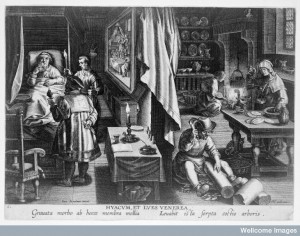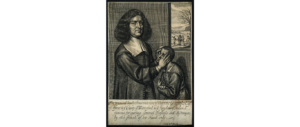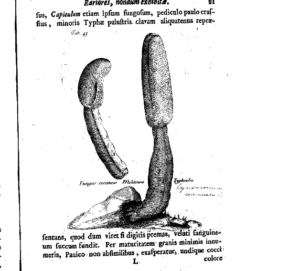In this week’s blog I want to talk a little bit about venereal disease. It has made regular appearances in my research over the last few months and I am always left wondering the same thing – were people ashamed to have venereal disease? Did they attempt to keep it a secret? or was it so common that it was not shameful to be treated for the pox? This is rather a complex issue and so (advanced warning!) this is a slightly longer blog post than usual.
(If you want to read more about living with a venereal disease in early modern England head over to the Sloane Letters blog and read this excellent post: http://www.sloaneletters.com/suffering-venereal-disease-in-the-early-eighteenth-century/)
Venereal disease (the Great Pox, the French Pox or the French Disease) appeared in Europe in the late 15th century and spread rapidly throughout Europe. This ‘disease’ included both syphilis and gonorrhea – an uncontrolled shedding of corrupt seminal matter from the genitalia. Medical treatises well understood that venereal disease was a contagious illness caught particularly through improper and unclean ‘copulation’ with filthy and lewd women. Thus the disease was associated with illicit, irregular and immodest sexual behaviour. These associations encouraged a sense of secrecy and privacy surrounding venereal disease to develop. Indeed the text we will be looking at shortly called venereal disease The Secret Disease or Secret Infirmity.
In general syphilis was not a very easy disease to hide. The symptoms of the disease, pocks and pustules, were very visible. The traditional treatments for venereal disease were also not very discreet. Salivation with mercury required patients to stay inside for protracted lengths of time while the venereal venom was sweated out of their body. This meant that patients had to be absent from everyday activities: socializing, running a business, going to work etc. Mercurial treatment could also result in symptoms including disfigurement of the mouth and nose.
protracted lengths of time while the venereal venom was sweated out of their body. This meant that patients had to be absent from everyday activities: socializing, running a business, going to work etc. Mercurial treatment could also result in symptoms including disfigurement of the mouth and nose.
The stigma and potential visibility of the disease and its treatmets, Kevin Siena has suggested, changed the ways in which patients demanded medical care, and the ways in which practitioners offered treatment.1 This new development meant that privacy and medical confidentiality were suddenly very important; Siena even suggests that male sufferers asked their surgeons and medical practitoners to hide their condition from their wives. More shockingly (to us anway) some of these male patients even asked this when they had infected their wives, getting surgeons to lie to the suffering woman about the nature of her disease! 2 Yet others have suggested that for libertines venereal disease could be a badge of honour, a symbol of their sexual activity, albeit a rather dangerous and painful one.3
We can examine these tensions of secrecy and privacy by looking at the ways in which one series of medical pamphlets approached this issue. The Practical Scheme of Secret Injuries. And Broken Constitutions (1719) and The Secret Patient’s Diary (1725). These early eighteenth-century pamphlets were produced to look like small medical treatises and were designed to sell the author’s patent drugs to potential customers. Although they cannot accurately represent the individual thoughts of venereal patients, the author needed to make his comments resonate with contemporary ideas; they therefore tell us what the author thought his patients wanted to hear.
The author seems to be in a little bit of a quandary about secrecy and privacy. On the one hand they are committed to the idea that their medicines provide the embarrassed customer with a clever means of safely and secretly curing their venereal disease. It is pointed out that these medicines can be purchased by letter without a medical consultation. Therefore the patient doesn’t even need to reveal their condition to a doctor. Indeed in the Secret Patients Journal an entire page is dedicated to this idea.
The author goes further however explaining that these remedies could be taken privately in the home. He also suggests customers that if necessity requires a patient to be out and about they can still take this medicine in secret:

‘The use of it is so easy that a Person may carry this Elixir about with them in their Pocket, and take some Drops of it in a Glass of Wine, Ale, Beer, Whey, &c. as well aborad as at home. Gentlemen at the Coffee-House, Tavern, or any other publick House may take the Bottle out of their Pocket and put a few Drops into their Ale, Wine, Beer, &c. by way of Bitter Stomachick Drops, & no body ever know for what end they take them’ 4
This is quite a coup for the patient, who can retain their modesty and pull the wool over the eyes of those around them, including their closest friends and relatives, even their bedfellows (many men and women in the early modern period shared their bed with another person of the same sex). Unlike mercurial treatments that revealed the patient’s condition by their long absence from business, this remedy allowed men to continue in their work and maintain the illusion of perfect health:
‘It making the Person (who before was Dejected, Spiritless, and cast Down) surprisingly Easy, Chearful, and well, as if no such Misfortune had been: And this without Confinement, or Hindrance from any Business, or Travelling, or the Knowlege [sic] of even a Bedfellow, `tis so Secret and Easy a Cure. Because Washing the Part with this Lotion, being with the utmost Privacy, and SOON DONE, can never betray a Person even to a Bedfellow, if they will but be True to themselves. 5
So far then it would seem that the author offered embarrassed men, and women, the option of treating their disease in private without anyone ever finding out. However, the author is also a great pains to highlight how marvellously effective these medicines were, and this is where his privacy statements are slightly undone.
Firstly the author, as was standard with many advertisements from the era, included letters from happy customers reporting on their own fantastic recovery. Although the author noted that some of these had to be published anonymously because he did not have permission to print their names (suggesting that some patients really did want secrecy), others were named (and shamed?) including William Smith, who wrote that he was ‘beyond my own expectation Cured with all the ease, secrecy and expedition you promise’.6 This statement perhaps leaves us wondering what good this secrecy was if Smith then willingly published his own name as a sufferer of the pox.
Even letters without names tell us something about the need for privacy. The following letter did not mention anyone by name but suggests that some husbands were not desperate to keep their disorders secret or hide the fact that they had infected their wives. Indeed the wife in this case appears remarkably calm given that her philandering husband has infected her with syphilis!
SIR May 11. 1716,
OUT of Grati[t]ude to you, I cannot but let you know the unexp[e]cted success I found by your Specifick Remedy: For about [a] Year and half ago, I got the Secret Disease to a very mis[e]rable degree. I went to a very eminent Surgeon, (who out of r[e]spect to his Acquaintance with me I shall forbear to Name) I was und[e]r his Hands three Months, & then I found my self much worse, tho I was most regular in Living, and followed his Instructions to a Tittle. He told me noth[i]ng would do but a Salivation: But I being in a publick business, my Attendance would not be dispensed withal, which drove me almost to Despair, thinking I must die of that loathsome Disease. A Friend of mine told me his Life for mine, your Specifick Remedy would Cure me; upon which I was resolved to try it, I bought it, and took of it, and before I had taken half the Remedy I found my self so perfectly well, that I took no more, and never fou[n]d any Disorder since. But about a Month ago I got another Clap, and unfortunat[e]ly gave it to my Wife, I did not despair of a Cure seeing your Remedy was extant. But first I tried whether there was any Virtue in the half Pot I had l[e]ft: We both of us took of it, & we found our selves quite Cured [a]nd so sav[e]d the laying out of another Guinea.’ 7
Moreover, the author noted that the effects of his drug were just so wonderful that those who had recovered with its help were simply unable to refrain from telling others about its effects: ‘These Gentlemen finding themselves surprisingly Cured by it, presently recommended it to their Acquaintance under the same Unhappy Circumstances; and who experiencing the same happy Effect from it, Recommended it also to others.’8 If this were truly the case it suggests that some men were not ashamed to admit they had contracted the pox once they were fully healed. It also suggests that some men revealed to their friends that they had the disease before they were cured – otherwise there would be no need for ‘these Gentlemen’ to be so helpful and suggest a remedy to their unhappy circumstances.
It is apparent then that privacy and secrecy were certainly crucial ideas surrounding the treatment of venereal disease. There was clearly some desire to be able to hide the results of shameful behaviour and illicit sexual practices. Yet these pamphlets also suggest an openness about venereal disease, particularly the need to talk to friends and relatives about good cures and methods of treatments. Although it doesn’t appear in this literature that pocks were worn as badge of honour, there were evidently some men, and perhaps women, who were not squeamish about owning up to having caught venereal disease.
____________________
1 Kevin P. Siena, ‘The “Foul Disease” and Privacy: The Effects of Venereal Disease and Patient Demand on the Medical Marketplace in Early Modern London’, Bulletin of the History of Medicine, 75/2. (Summer 2001), 199-224.
2 Ibid, 215.
3 Katherine Crawford, European Sexualities, 1400-1800, p.136.
4 Anonymous, The Practical Scheme of Secret Injuries. And Broken Constitutions. By Fast Living, Former ill Cures, Salivations and Mercury. With an Appendix of Gleets, And other such Weaknesses in either sex, usually attending Persons after Former Cures, Overstainin, Self-Abuses, Hard Labours, Miscarriages, &c. … (London, 1719), p.14
5 Anonymous, The Secret Patient’s Diary: Also the Gout and Weakness Diaries. Being Each A Practical Journal or Scheme from Day to Day , of these Disorders, whilst a Person has the Secret Disease, or the Gout, or Rheumatism, or a Gleet upon them … (London, 1725)
6 Anonymous, The Practical Scheme of Secret Injuries, p.19.
7 Ibid, p. 26.
8 Anonymous, The Secret Patient’s Diary, p.9.
© Jennifer Evans, all rights reserved.




One thought on “The Secret Disease?”
Comments are closed.